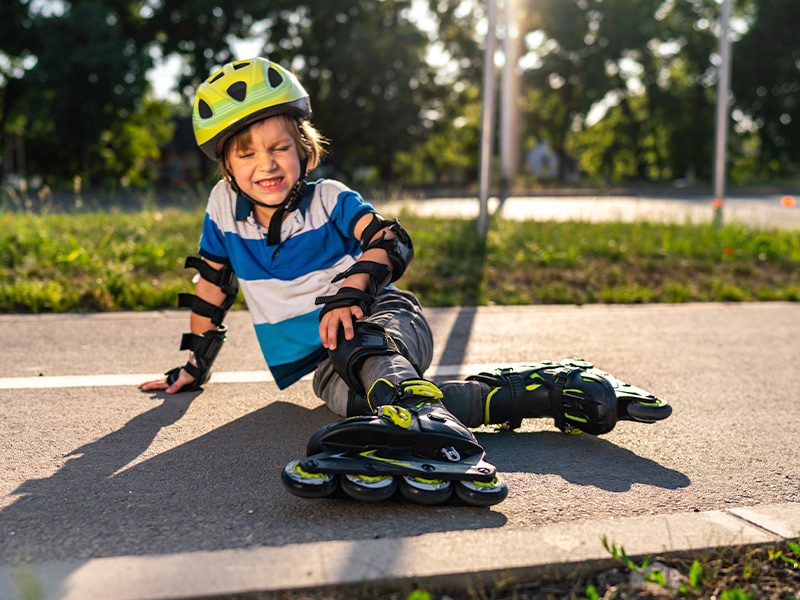How to score big on sports safety for kids
With competitive sports kicking off again, it’s the perfect time to check which safety gear your child needs to stay in the game without getting hurt.
When Macquarie University researchers decided to look at trends in sports-related injuries among Aussie kids over a 10-year period, the results were surprising.
Despite efforts from governments and sporting bodies to make sport safer, the rate at which children were being admitted to hospital for sports injuries had hardly budged over a decade, with around 130,000 being hospitalised each year.
Most of the patients were older boys, and the biggest causes of injuries were team ball sports, at 43 per cent, and so-called “wheeled non-motor sports”, at 22 per cent.
Common injuries include strains and sprains, head injuries, ACL damage, and bone and muscle injuries.
“Participating in sports offers incredible social, emotional and physical benefits for kids, but we know that one of the worst things is being on the sidelines with an injury,” physiotherapist and sports science expert Melanie McAuliffe says.
“As parents and coaches, there are some simple things we can do to help reduce preventable injuries so that our kids can continue playing the games they love.”
Sports safety gear for kids
Mouthguards
Studies have found up to 40 per cent of dental injuries in children occur during sports and may be prevented by using mouthguards.
Dentist Dr Janani Ravichandran says a sports mouthguard can protect kids from some serious sporting injuries, such as broken jaws; fractured, cracked or knocked-out teeth; and cut lips and tongues.
“Where an oral injury is more serious, it can be difficult to treat and often involves a great deal of expense which can lead to years of dental treatment,” Dr Ravichandran, of the Australian Dental Association, says.
And, she adds, it’s not only obvious contact sports but also sports such as cricket, basketball, netball, touch football, skateboarding and soccer that carry a risk of accidental collision.
The ADA recommends custom-made mouthguards – created by a dentist, these are the most protective for the teeth and mouth as they are specially designed to fit the exact contours of your child’s mouth.
“They’re also comfortable to wear, and allow children to breathe and speak more easily compared to the store-bought options,” Dr Ravichandran says.
Helmets and headgear
Protective headgear, such as a properly fitted helmet, is important to protect your child’s head from impact and penetration injuries when playing sports, Melanie says.
“This can be important for obvious contact sports like rugby, football and hockey, but also in soccer and non-contact sports like biking and skateboarding,” she adds.
“You need to make sure it fits snugly and covers the forehead, and kids know how to wear it properly.”
- Keep moving: 5 reasons for kids to stay active
Chest protectors, shin guards and knee pads
In sports such as baseball, softball, rugby, lacrosse, dirt biking and martial arts, shoulder and chest safety are super important.
A chest protector helps to protect the ribs and internal organs from impact, says Melanie.
“All kinds of sports, from soccer to cricket to skateboarding, use protective pads such as shin, wrist, elbow, knee and even thigh guards that help shield vulnerable body parts,” she adds.
Protective footwear
“Yes, many kids think they can play sports in their Vans, but the reality is wearing the right footwear is really important,” Melanie says.
“I see so many kids with sprained ankles and ACL injuries because they’ve been playing sport with shoes that have no tread or grip, or that don’t properly support their feet – many sports need a special type of footwear such as footy or soccer boots, for example.”
- Time out: How much exercise does your child need?
Eyewear
A 2022 study led by The Royal Victorian Eye and Ear Hospital found that soccer, AFL and basketball are listed as the top three sports related to emergency eye trauma.
“We hope the findings help to update guidelines and promote policy changes, particularly for young people,” study author Dr Rahul Chakrabarti says.
Other common sports that require eye protection, such as goggles and face shields, include ice hockey, baseball, softball, field hockey and lacrosse as the risk of getting hit in the eye with a ball or stick or another player’s equipment is high.
Always wear your sports safety gear
“Encourage and remind your kids to wear their protective equipment at all times, even during training, and make sure it fits properly and is in good condition, so they can enjoy everything that playing sport has to offer,” Melanie advises.
Written by Liz McGrath.





